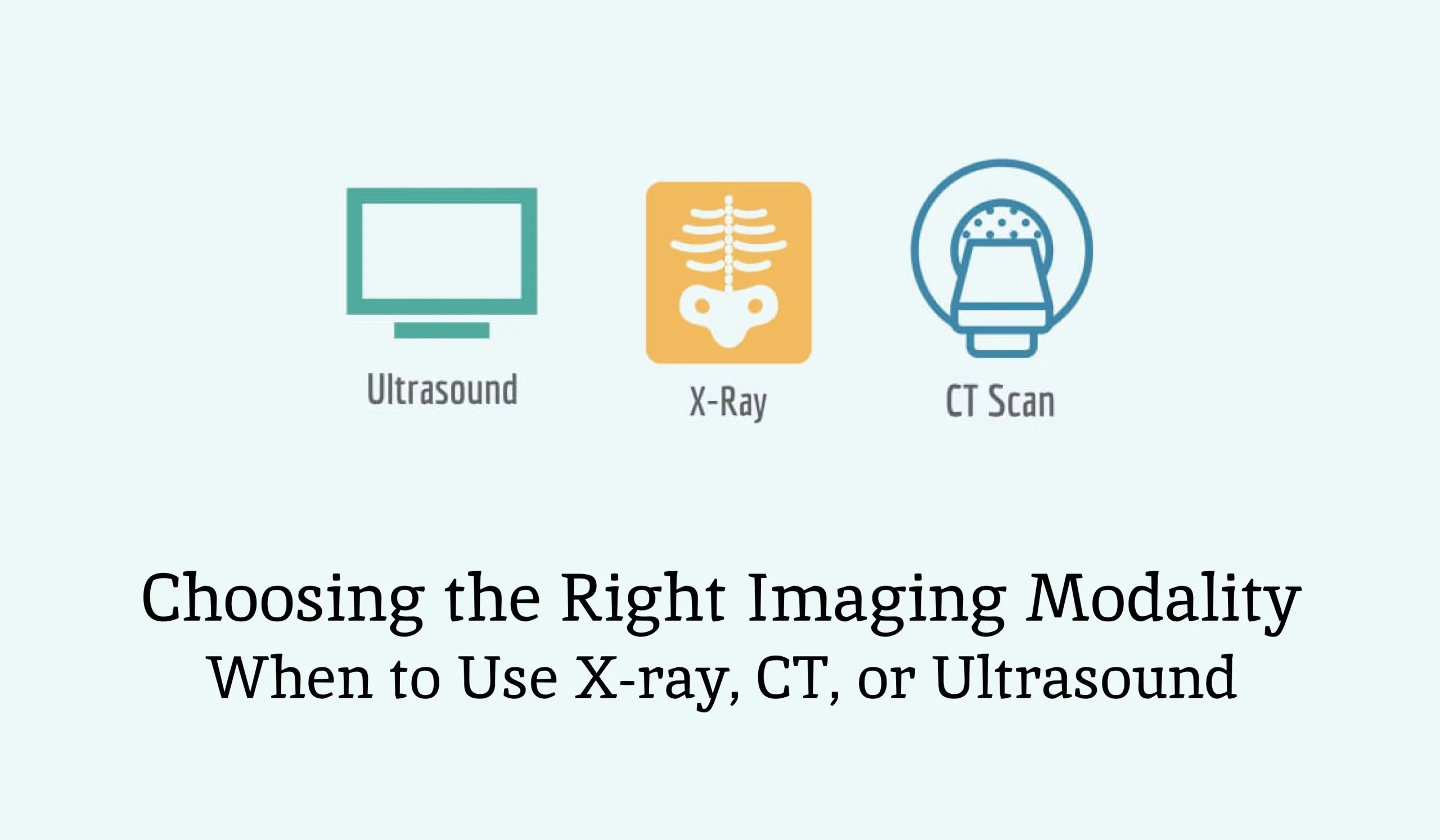In the field of diagnostic imaging, selecting the appropriate modality is crucial for accurate diagnosis and effective treatment. With various options like X-rays, CT scans, and ultrasounds, each modality has its strengths and limitations, making them suitable for different medical conditions.
This blog will guide you through the process of choosing the right imaging modality, focusing on when to use each modality during treatment.
Diagnostic Imaging
Diagnostic imaging encompasses a range of techniques used to create visual representations of the interior of a body for clinical analysis and medical intervention. These imaging solutions are vital in diagnosing a wide array of conditions, from broken bones to soft tissue injuries and internal organ assessments. The choice of imaging modality depends on the type of tissue examined, the nature of the suspected condition, and the specific clinical questions that need answering.
X-ray Imaging: The First Line of Defence
X-ray imaging is often the first choice for evaluating bone injuries and certain chest and abdominal conditions. It works by passing a small amount of radiation through the body to capture images of dense structures like bones.
When to Use X-rays?
1. Bone Fractures and Dislocations
X-rays are the go-to modality for identifying bone fractures and dislocations. They provide a clear image of the bone structure, making it easy to spot breaks or misalignments. If you’ve been injured and need to check for fractures, booking an x ray appointment is often the first step.
2. Chest Conditions
X-rays are also widely used to diagnose chest conditions, including pneumonia, tuberculosis, and lung cancer. The ability of X-rays to capture images of dense structures like the ribs and spine makes them suitable for detecting abnormalities in the chest area.
3. Dental Imaging (OPG)
X-rays, specifically Orthopantomograms (OPG), are used in dental imaging to capture panoramic views of the upper and lower jaws, teeth, and surrounding bones. OPG/CBCT scans are essential in planning dental surgeries and diagnosing oral health issues.
imitations of X-rays
- Soft Tissue Imaging
X-rays are not ideal for imaging soft tissues like muscles, tendons, or internal organs, as they lack the detail needed to differentiate between various tissue types.
Radiation Exposure
While the radiation dose in an X-ray is low, repeated exposure can accumulate over time, which is a consideration for patients requiring frequent imaging.
CT Scans: Detailed Cross-Sectional Imaging
Computed Tomography (CT) scans are advanced imaging techniques that use X-rays to create detailed cross-sectional images of the body. CT scans provide more detailed information than standard X-rays, making them useful in complex cases where more information is needed.
When to Use CT Scans?
Complex Fractures
When a standard X-ray doesn’t provide enough detail, an OPG CT scan gives a more comprehensive view of complex fractures, especially in areas like the spine or pelvis.
Head Injuries and Brain Imaging
CT scans are the preferred modality for assessing head injuries, strokes, and brain tumours. The detailed images allow doctors to see brain structures and detect abnormalities like bleeding, swelling, or masses.
Abdominal and Pelvic Conditions
CT scans are highly effective in diagnosing conditions related to the abdomen and pelvis, such as appendicitis, kidney stones, and cancers of the liver, pancreas, and other organs.
Chest and Lung Diseases
When a chest X-ray is inconclusive, a CT scan can provide more detailed images of the lungs and surrounding structures, helping to diagnose conditions like pulmonary embolism, lung cancer, or severe infections.
Limitations of CT Scans
Radiation Exposure
CT scans involve higher doses of radiation than standard X-rays, which is a significant consideration for patients requiring multiple scans.
Soft Tissue Contrast
Although CT scans provide more detail than X-rays, they may still be limited in their ability to differentiate between certain soft tissues without the use of contrast agents.
Ultrasound Imaging: Safe and Versatile
Ultrasound imaging uses high-frequency sound waves to produce images of the inside of the body. Unlike X-rays and CT scans, ultrasound does not involve radiation, making it a safer option, particularly for pregnant women and repeated scans.
When to Use Ultrasound?
Musculoskeletal (MSK) Ultrasound
Musculoskeletal ultrasound is the preferred modality for imaging soft tissues like muscles, tendons, and ligaments. It’s particularly useful for diagnosing sports injuries, tendonitis, and bursitis. If you suspect a soft tissue injury, booking a musculoskeletal ultrasound scan can provide detailed images of the affected area. Additionally, the MSK ultrasound cost is generally lower than that of a CT scan or MRI, making it a cost-effective option for many patients.
Women’s Health (Specialist Women’s Ultrasound)
Ultrasound plays a critical role in women’s health, especially during pregnancy. Specialist women’s ultrasound is used for prenatal screening, monitoring foetal development, and diagnosing conditions related to the female reproductive system, such as ovarian cysts, uterine fibroids, and endometriosis. The non-invasive nature of ultrasound makes it the preferred choice for many women’s health diagnostics.
Abdominal and Pelvic Imaging
Ultrasound is commonly used to assess abdominal organs like the liver, gallbladder, kidneys, and pancreas. It’s also effective in diagnosing pelvic conditions, particularly in women, and can be used to guide certain procedures like biopsies.
Vascular Imaging
Ultrasound is widely used to examine blood flow in arteries and veins. Doppler ultrasound, a specialised form of ultrasound, can assess conditions like deep vein thrombosis (DVT) or blockages in the arteries.
Limitations of Ultrasound
1. Limited Penetration
Ultrasound waves have limited penetration, making it difficult to image structures deep within the body or those surrounded by bone.
2. Operator Dependent
The quality of an ultrasound image can vary significantly based on the skill of the operator, which means that less experienced technicians may not produce as accurate images as their more experienced counterparts.
Comparison of X-ray, CT, and Ultrasound
| Imaging Modality | Best for | Advantages | Disadvantages |
|---|---|---|---|
| X-ray | Bones, fractures, chest conditions, dental issues | Quick, widely available, cost-effective | Low radiation exposure, not suitable for soft tissue imaging |
| CT Scan | Complex fractures, head injuries, abdominal conditions | Detailed cross-sectional images | Higher radiation exposure than X-rays, may require contrast agents |
| Ultrasound | Soft tissues, muscles, tendons, organs | Safe, radiation-free, excellent for soft tissue imaging | Limited penetration, operator-dependent |
At Radiology Imaging Solutions (RIS), we provide top-tier diagnostic imaging services tailored to meet the diverse needs of our patients. With state-of-the-art technology and a team of experienced professionals, we offer a comprehensive range of imaging modalities, including X-rays, CT scans, and ultrasounds.
Our commitment to precision and patient care ensures that you receive the most accurate diagnoses and effective treatments. Whether you need a routine X-ray appointment, a detailed MSK ultrasound, or a specialist women ultrasound, Radiology Imaging Solutions is here to support your healthcare journey.
For more information or to book an appointment, contact RIS today.


Leave a Reply